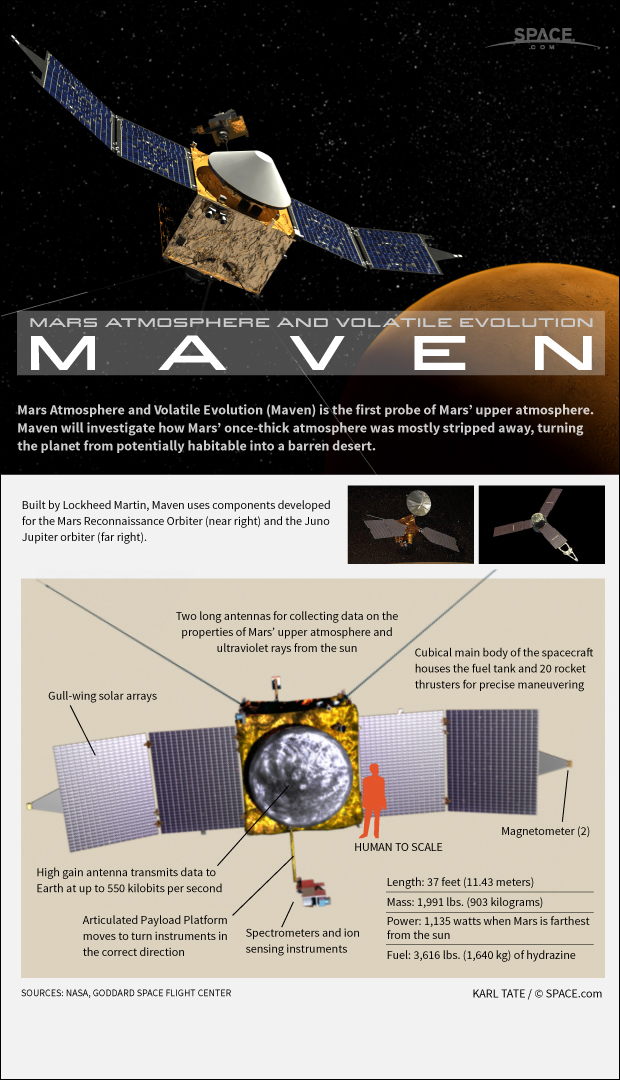NASA's New Mars Probe Could Help Set Stage for Manned Missions

CAPE CANAVERAL, Fla. — The NASA missions of today are paving the way toward launching a manned mission to Mars by the 2030s, space agency officials said Sunday (Nov. 17).
NASA's robotic missions can provide valuable data that could be used to launch future human missions to the Red Planet. The $671 million Mars Atmosphere and Volatile Evolution (MAVEN) mission — which launched from Cape Canaveral Air Force Station in Florida on Monday — could provide key information about how to land a human-occupied craft on the planet's surface.
The MAVEN spacecraft will explore Mars' upper atmosphere to understand how the planet may have lost most of its atmosphere to space, causing the planet to morph from a wet world that could have supported microbial life to the dry desert it is today. [The Boldest Mars Missions in History]

"The MAVEN mission will provide some interesting information for scientists," William Gerstenmaier, associate administrator for NASA's human exploration and operations directorate, told members of the press. "It's also good information for us on the human spaceflight front to understand how the atmosphere of Mars is put together … [Those factors] will be important as we look at entry, descent and landing into the Martian atmosphere with larger spacecraft than we've done before, the kind of spacecraft that were made for human missions."
MAVEN will also help scientists understand what kinds of resources are available in the Martian atmosphere and possibly how to utilize them during human exploration, Gerstenmaier added.

NASA is still developing the Orion spacecraft and the Space Launch System, which are designed to deliver humans to deep space destinations. Meanwhile, work on the International Space Station is helping scientists understand the toll a long spaceflight to Mars could take on the human body.
The year-long spaceflight to the station — planned to launch in 2015 — will give scientists a better sense of what the human body does in microgravity over a period of time similar to that of a flight to Mars, Gerstenmaier said.
Get the Space.com Newsletter
Breaking space news, the latest updates on rocket launches, skywatching events and more!
Putting humans on Mars would potentially allow for scientific opportunities not afforded by robotic probes and rovers.

"I'm a geologist, and I've spent most of my career out in the field picking up rocks," Ellen Stofan, NASA's chief scientist, said. "So I have this incredible bias that it is really going to take future astronauts, field geologists, astrobiologists at Mars picking up those rocks, doing the field surveys that geologists do here on Earth, taking this science not just from doing remote science, but doing science on the ground that's really going to help us get at this question of 'are we alone?'"

Learning how to colonize Mars sometime in the far future could also change humanity's place in the solar system.
"If you really want to think about the long-term future of humanity, I like to say that we live in a wonderfully diverse solar system with incredible ranges of environments, from Mercury to giant ice planets," John Grunsfeld, associate administrator for NASA's science mission directorate, said.
"But there are really only two places in the solar system that offer an opportunity for relatively easy living," Grunsfeld added. "One of which is Earth, and we're still learning how to do that, and the other really is Mars … Mars is our real opportunity to colonize another planet that's self-sustaining."
Follow Miriam Kramer @mirikramer and Google+. Follow us @Spacedotcom, Facebook and Google+. Original article on SPACE.com.
Join our Space Forums to keep talking space on the latest missions, night sky and more! And if you have a news tip, correction or comment, let us know at: community@space.com.

Miriam Kramer joined Space.com as a Staff Writer in December 2012. Since then, she has floated in weightlessness on a zero-gravity flight, felt the pull of 4-Gs in a trainer aircraft and watched rockets soar into space from Florida and Virginia. She also served as Space.com's lead space entertainment reporter, and enjoys all aspects of space news, astronomy and commercial spaceflight. Miriam has also presented space stories during live interviews with Fox News and other TV and radio outlets. She originally hails from Knoxville, Tennessee where she and her family would take trips to dark spots on the outskirts of town to watch meteor showers every year. She loves to travel and one day hopes to see the northern lights in person. Miriam is currently a space reporter with Axios, writing the Axios Space newsletter. You can follow Miriam on Twitter.









